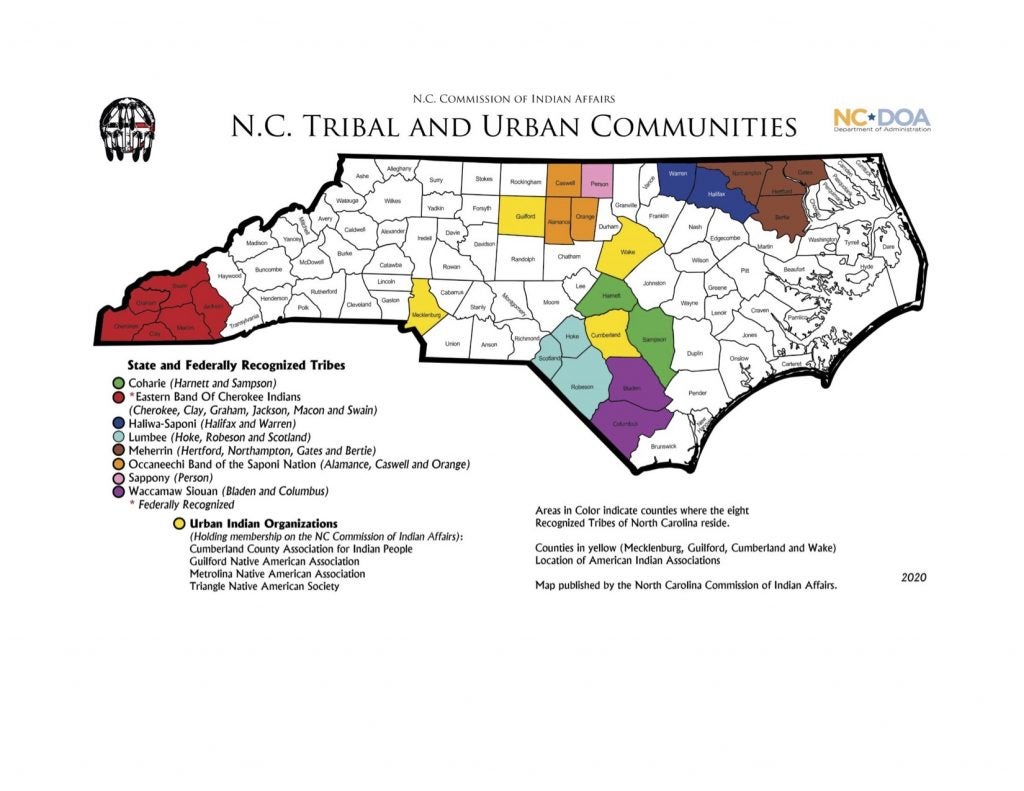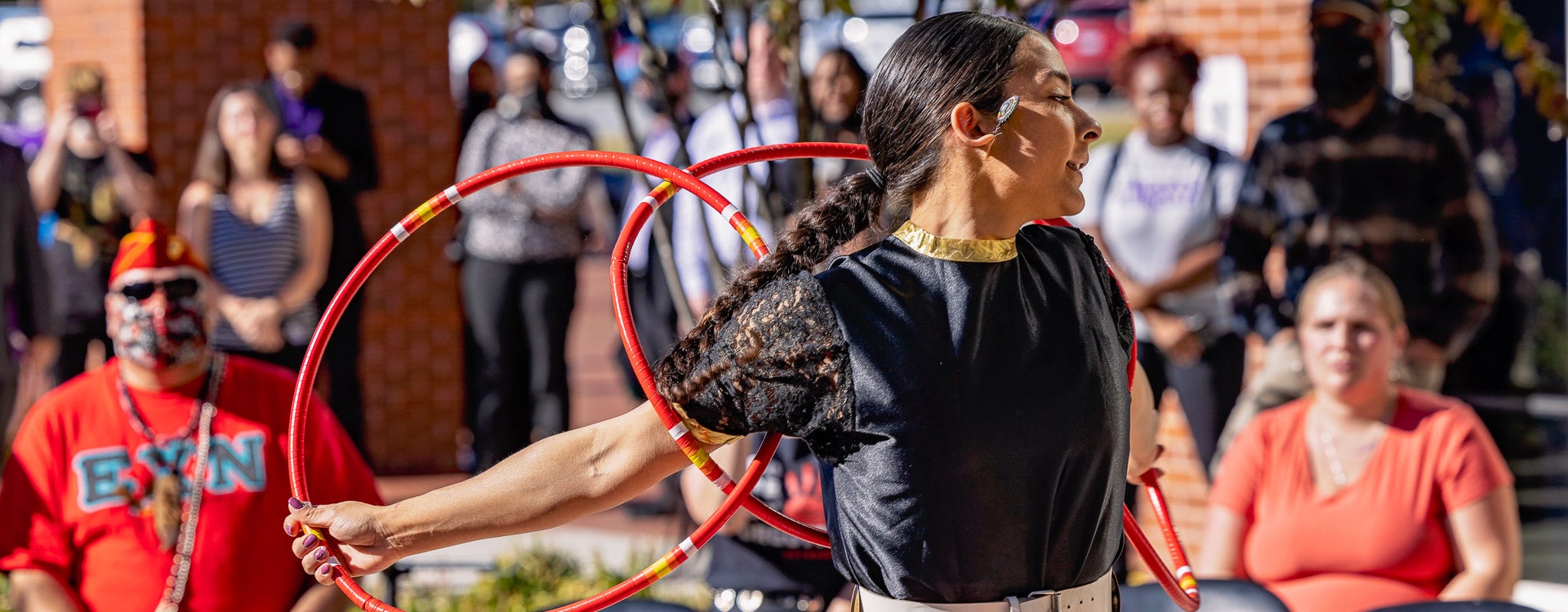Indigenous Space
Indigenous Affinity Priority Fund
ECU Indigenous Land Acknowledgement
ECU has acknowledged the contributions of the Indigenous People and established a designated outdoor space located on the ECU Main Campus Student Center (501 E. 10th Street, Greenville, NC 27858). The space
- Recognizes the history and impact of the Indigenous Tribes of Eastern NC.
- Celebrates Indigenous students, faculty, and staff.
- Demonstrates ECU’s commitment to diversity, scholarship, and service.
- Encourages unity, education, and collaboration among Pirate Nation.
The state and region have a long and rich Indigenous history. North Carolina has the largest Indigenous population (more than 120,000) of any state east of the Mississippi River, and the eighth largest Indigenous population in the United States. The majority of North Carolina’s Indigenous people live in the eastern half of the state. In 1971, the General Assembly formally established the North Carolina Commission of Indian Affairs to support the needs of Indigenous peoples. The state has recognized eight tribal nations: the Coharie, the Eastern Band of Cherokee, the Haliwa-Saponi, the Lumbee, the Meherrin, the Occaneechi Band of Sappony, the Sappony, and the Waccamaw-Siouan. Indigenous people from numerous other tribal nations also live in the state. While remembering the past, they presently look ahead to the future with pride in who they are and what they have achieved as citizens of the state and as native Carolinians.
Who are the Tuscarora?
Tuscarora Indians occupied much of the North Carolina inner Coastal Plain at the time of the Roanoke Island colonies in the 1580s. They were considered the most powerful tribal nation in what is now eastern North Carolina. The Tuscarora established their primary towns on or near the Roanoke, Neuse, Tar (Torhunta or Narhontes), Pamlico, and Cape Fear rivers in North Carolina. Noted by early Europeans the Tuscarora in North Carolina had three tribes: Kǎ’tě’nu’ā’kā’ (People of the Submerged Pine-tree, also written Kautanohakau); Akawěñtc’ākā’ (People of the Water, also Kauwetseka); and Skarū’ren’ (hemp gatherers, also known as Tuscarora). The villages were organized into confederacies. The most prominent were the Upper Town and Lower Town confederacies. Every town had a chief, or teethha, that held political power in conjunction with town councils.
White settlers in the Albemarle region fought sporadically with the Tuscaroras from 1664 to 1667. The conflict apparently began with the encroachment of a group of refugee Virginia Quakers on lands claimed by the tribe. Whites thereafter avoided further encroachment, recognizing the west side of Chowan River as Tuscarora country until after 1700. In September of 1711, Chief Hancock of the Lower Tuscarora confederacy organized an alliance of Tuscaroras and warriors from other tribal nations in the region. Worried about the effects of English colonization, such as land encroachment and the slave trade, Hancock and his supporters attacked North Carolina colonists, initiating the Tuscarora War. In 1713, the Southern Tuscarora were defeated at their Fort Neoheroka (formerly spelled Neherooka), located in Snow Hill, NC. After their clash with colonists, many Tuscaroras moved to New York and joined the League of the Iroquois. The remaining members that chose not to relocate (nearly 650 Tuscarora families) continue to live in North Carolina and parts of Virginia and South Carolina.
N.C. Tribal and Urban Communities
North Carolina is home to 8 state recognized tribes and 4 urban Indian organizations.
Click here to download a printer-friendly map of the Tribal Nations and Urban Indian Organizations in North Carolina located below.

Know the Land
What is a Land Acknowledgment?
A Land Acknowledgment is a formal statement that recognizes and respects Indigenous Peoples as traditional stewards of this land and the enduring relationship that exists between Indigenous Peoples and their traditional territories.
Why do we recognize the land?
To recognize the land is an expression of gratitude and appreciation to those whose territory you reside on and a way of honoring the Indigenous people who have been living and working on the land from time immemorial. It is important to understand the long-standing history that has brought you to reside on the land, and to seek to understand your place within that history. Land acknowledgments do not exist in a past tense, or historical context: colonialism is a current ongoing process, and we need to build our mindfulness of our present participation. It is also worth noting that acknowledging the land is Indigenous protocol.
How to Use the Land Acknowledgment
The Land Acknowledgement Statement can be read aloud or distributed by anyone who wishes to use it — at public or private events — on University property.
Land Acknowledgement Statement
Read this at your events and gatherings:
“We acknowledge the Tuscarora people, who are the traditional custodians of the land on which we work and live, and recognize their continuing connection to the land, water, and air that Greenville consumes. We pay respect to the eight state-recognized tribes of North Carolina; Coharie, Eastern Band of Cherokee, Haliwa-Saponi, Lumbee, Meherrin, Occaneechi Band of Saponi, Sappony, and Waccamaw-Siouan, all Nations, and their elders past, present, and emerging.”
Pronunciation Guide:
Tuscarora (TUSK-UH-RAW-RUH)
Coharie (co-HAIR-ee)
Eastern Band of Cherokee (cheh·ruh·kee)
Haliwa-Saponi (HA-lih-WAH suh-PONY)
Lumbee (LUM-bee)
Meherrin (ma-HAIR-in)
Occaneechi Band of Saponi (OAK-uh-NEE-chee suh-PONY)
Sappony (suh-PONY)
Waccamaw-Siouan (WOK-uh-ma Soo-uh n)
